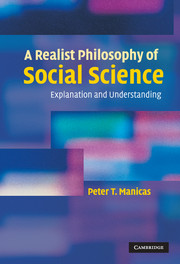Book contents
- Frontmatter
- Contents
- Acknowledgements
- Introduction
- 1 Explanation and understanding
- 2 Theory, experiment and the metaphysics of Laplace
- 3 Explanation and understanding in the social sciences
- 4 Agents and generative social mechanisms
- 5 Social science and history
- 6 Markets as social mechanisms
- Appendix A The limits of multiple regression
- Appendix B Comparison, Mill's methods and narrative
- Appendix C Rational choice theory and historical sociology
- Appendix D The neo-classical model
- References
- Index
4 - Agents and generative social mechanisms
Published online by Cambridge University Press: 12 November 2009
- Frontmatter
- Contents
- Acknowledgements
- Introduction
- 1 Explanation and understanding
- 2 Theory, experiment and the metaphysics of Laplace
- 3 Explanation and understanding in the social sciences
- 4 Agents and generative social mechanisms
- 5 Social science and history
- 6 Markets as social mechanisms
- Appendix A The limits of multiple regression
- Appendix B Comparison, Mill's methods and narrative
- Appendix C Rational choice theory and historical sociology
- Appendix D The neo-classical model
- References
- Index
Summary
Introduction
In those sciences we termed “abstract,” theory provides representations of the generative mechanisms, including hypotheses regarding ontology, for example, that there are atoms, and hypotheses regarding causal processes, for example, that atoms form molecules in accordance with principles of binding. We noted also that a regression to more fundamental elements and processes also became possible. So quantum theory offers generative mechanisms of processes in molecular chemistry. Typically, for any process, there will be at least one mechanism operating, although for such complex processes as organic growth there will be many mechanisms at work. Theories that represent generative mechanisms give us understanding. We make exactly this move as regards understanding in the social sciences, except that, of course, the mechanisms are social. As with complex natural processes, typically, there will be many mechanisms at work. As in the physical sciences, the theorizing of mechanisms in the effort to understand is not the only task of social science. As we argued, understanding presupposes good description, both quantitative and qualitative. Finally, we will need to consider the problem of explaining events and episodes. This is developed in chapter 5.
The foregoing has also argued that persons are the dominant causal agents in society – even while, of course, they work with materials at hand. It follows, accordingly, that in the social sciences, the generative mechanisms of social outcomes are the actions of persons and no further reduction is either plausible or demanded.
- Type
- Chapter
- Information
- A Realist Philosophy of Social ScienceExplanation and Understanding, pp. 75 - 102Publisher: Cambridge University PressPrint publication year: 2006
- 1
- Cited by

